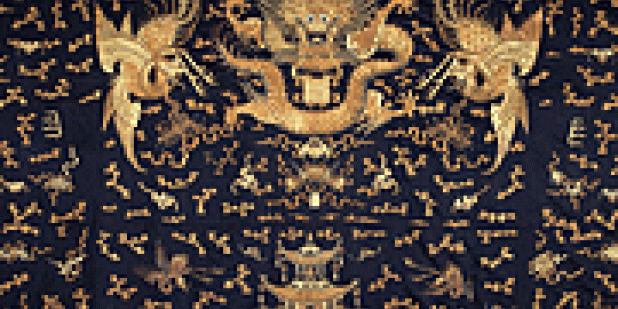Happy Lunar New Year from the USC US-China Institute!
Threads of Heaven: Silken Legacy of China’s Last Dynasty
The Denver Art Museum presents an exhibition on Chinese textiles and costumes of the Qing Dynasty.
Where

The Denver Art Museum’s Chinese textiles and costumes take center stage in Threads of Heaven: Silken Legacy of China’s Last Dynasty. In the first extensive special exhibition of these objects in thirty years, visitors will find a panorama of court and informal robes, exquisitely detailed personal accessories, and dramatic wall hangings drawn entirely from the permanent collection. In 1981, Secret Splendors of the Chinese Court debuted robes and accessories collected by Charlotte Hill Grant in China during the 1920s and 1930s, following a gift of over 600 Qing Dynasty pieces to the museum by Mrs. Grant’s children, James P. Grant and Betty Grant Austin, in 1977. In addition to preeminent items from the earlier exhibition, Threads of Heaven showcases many objects rarely or never exhibited, both from the Grant collection and other donors.
The treasures on view provide a glimpse into court life during the last century the Qing Dynasty. In 1644 Manchu forces from the north conquered China. Ethnically distinct from the more populous Han Chinese, they founded the Qing Dynasty, which lasted until the deposition of the child-emperor Pu Yi—the last Emperor of China—by the 1911 Chinese revolution. The objects in Threads of Heaven date primarily to the period when Empress Dowager Cixi (1835-1908) ruled “from behind the curtain.” The daughter of an ordinary official, she became a royal concubine at eighteen and gave birth to the emperor’s sole male heir in 1856. When her son became emperor in 1861, her power increased. She ousted his appointed regents, assuming nearly absolute control of the government. She maintained her position after his death in 1875 by appointing her young nephew and adopted son emperor. Cixi’s power was threatened when foreign forces moved into Beijing in 1900. She and the emperor fled, but returned in 1902. In 1908, a day after the emperor’s death, she chose his successor from her own deathbed.
As rulers of China, the Manchu asserted their ethnic identity by keeping elements of their traditional clothing style. The Manchu dragon robe (jifu) was a semiformal court garment used for festive occasions. Unlike the flowing robes of the more sedentary Han Chinese, the cut of the Manchu man’s garment reflected the formerly nomadic horseman’s need for protection and mobility: an overlapped front panel securely fastened to keep the hands free; flared “horse-hoof” cuffs protected the back of the hand; and vents at the front and back made riding easy.
Intricate motifs decorating each object—whether embroidered in gold and silk, as in the imperial cover pictured, or finely woven—tell a story and invite a closer look. The dragon and phoenix, symbols of the emperor and empress, dominate this hanging. Dragons, symbols of authority for centuries, linked the Qing Dynasty to the continuum of imperial rule. A multitude of bats, whose name, fu, sounds the same as the word for good fortune, fill the background along with images of the eight auspicious Buddhist symbols, four scholarly pursuits, and clouds representing the granting of a wish. At the bottom of the hanging, carp turning into dragons symbolize the successful passing of imperial exams. The pagoda in the sea is a longevity motif. Two cranes each carry a bamboo counter to be placed in the vase within the building: the counters represent the time it takes for the ocean to change to solid land.
Featured Articles
We note the passing of many prominent individuals who played some role in U.S.-China affairs, whether in politics, economics or in helping people in one place understand the other.
Events
Ying Zhu looks at new developments for Chinese and global streaming services.
David Zweig examines China's talent recruitment efforts, particularly towards those scientists and engineers who left China for further study. U.S. universities, labs and companies have long brought in talent from China. Are such people still welcome?






